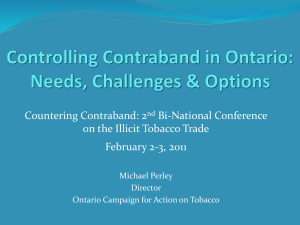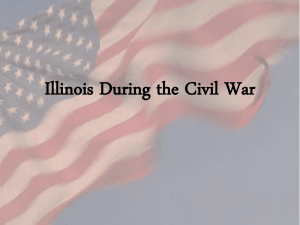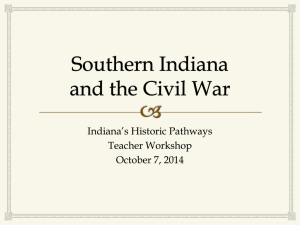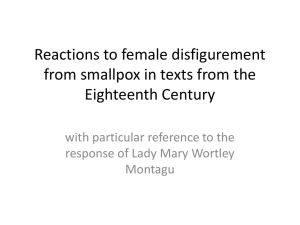“Contrabands” Camps and Lives DC Historical Studies Conference
advertisement
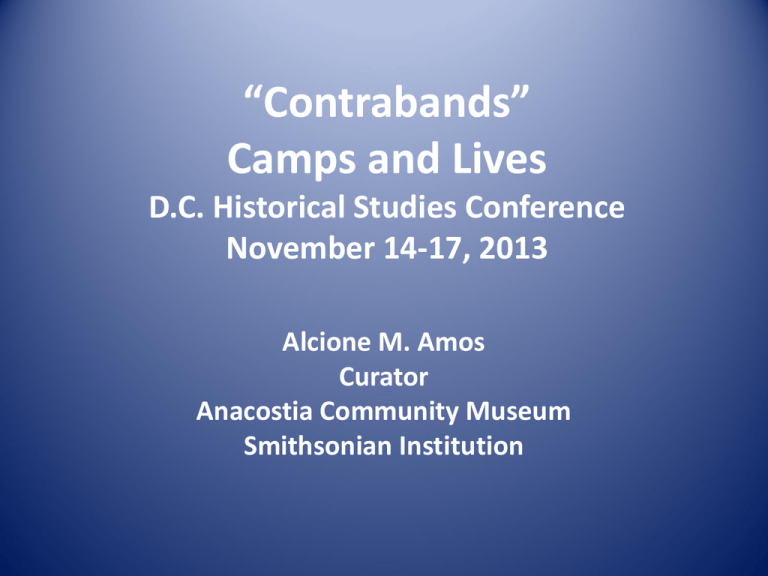
“Contrabands” Camps and Lives D.C. Historical Studies Conference November 14-17, 2013 Alcione M. Amos Curator Anacostia Community Museum Smithsonian Institution The Term “Contraband” The upheaval of the Civil War produced an increasing number of slaves who run away from their owners into the Union lines looking for protection. The term “contraband” originated from the decision by Major General Benjamin Butler not to return three fugitive slaves who had came into the Union lines at Fort Monroe, Virginia at Hampton Roads on the night of May 23, 1861. Butler decided to hold them as war loot. Although Butler did not name them as “contrabands” at the time, the term came into current usage later that year. “Contrabands” in Washington In Washington “contrabands” started arriving from Maryland and Virginia in 1861. At first there were small numbers, but by 1862 the influx had become a flood and by 1864 an estimated 50,000 AfricanAmerican refugees had moved within the area protected by the ring of forts that surrounded the capital city. They were also the vanguard of the large African-American community that would settle in Washington, D.C. and would comprise the majority of the city’s residents by the late 1950s. Unidentified Civil War “Contraband” To House and Control “Contrabands” The government tried to organize the influx of “contrabands” into Washington by housing them in locations where supposedly they could receive assistance and at the same time be controlled. Between 1861 and 1865 AfricanAmerican refugees were housed in different locations in and around Washington. Most of this effort was not successful and subjected the refugee population to much suffering. Washington’s Black Hole, Capitol Washington’s marshal Hill, jailed fugitive slaves in December 1861 the “Old Capitol Prison,” under less than salubrious circumstances. Frank Leslie’s Illustrated Newspaper, called it “The Black Hole of Washington, D.C.” Today the Supreme Court stands in its place. Duff Green’s Row, Capitol Hill May 1862 As more and more refugees arrived they were moved to Duff Green’s Row, a row of townhouses on the east side of the 100 block of 1st Street on Capitol Hill. The “contrabands” housed there were sick with measles, diphtheria, and typhoid fever and living in squalor. Finally, the dreaded smallpox broke out among the refugees and it was feared that the outbreak would spread throughout the city. Today one of the Library of Congress buildings stands at this location. Camp Barker “Contraband” Camp, 1863 With the outbreak of smallpox at Duff Green’s Row it was decided that the refugees should be moved to a site to the North, beyond the limits of the city, near 13th Street between R and S Streets. The only freshwater available came from a well which was contaminated and caused diarrhea. Smallpox remained rampant among the residents and mortality was extremely high. Between June 1862 and April 1864 about one in seven people who came into the camp died. The location of the camp is today in the affluent neighborhood of Logan Circle. Mason’s Island Contraband Camp, 1864 In 1863 Mason’s Island was used as a training camp for African-American detachments from Washington and then as a “contraband” camp in 1864. The “contraband” camp was disbanded in July of 1865. Today there are no remnants of the camp in what is now known as Roosevelt Island. In 1863 the U.S. Army established Freedmen's Village on General Robert E. Lee's former Arlington estate. Envisioned as a temporary settlement to provide housing and work to assimilate former slaves into post-slavery society, it became a permanent home for hundreds of African-Americans. By 1870 the Army took control of the camp and in 1887 ordered the residents to vacate within 90 days. They fought to remain but eventually lost the fight and in March of 1900 all had to leave. Freedmen’s Village Early Residents in the 1860s “Contraband” Lives Although the “contrabands” were listed as statistics in the military records and later, when they were “freedmen,” in the records of the Freedmen's Bureau, each one of them was a human being. They were individuals with aspirations for a successful life coming out of slavery. They wanted a safe place to live, to find work to support their families, schools for their children, a church where they could worship, and finally, a hallowed ground for their burial when the time came to meet their Lord. Here we share the life histories of two of these individuals who fled slavery and moved to Washington as “contrabands” and built their postslavery lives here. Keith Sutherland Son of Rachel and Sandy Sutherland. He came to Washington as a child in 1864 from Maryland. Rachel and Sandy worked as hospital orderlies and Keith was a bootblack near the Treasury Building in downtown Washington and proudly reported years later that he had seen the funeral cortege for President Lincoln. Freedmen’s Bank Card for the Sutherland Family, 1871 Hell’s Bottom After the Civil War the Sutherland family lived and run a business in the area which became known as Hell’s Bottom Keith Sutherland and his Fairview Hotel An early version of a Washington D.C. Food Truck! Maria Toliver “I was born in Williamsburg Va., and was sold into King William County, Va., and run off from my master about 1862 and I came here to Washington D.C.” With this straightforward statement, made some 35 years after the events, Maria Toliver told the tale of how she became a “contraband.” Contrabands at Cumberland Landing, King William County, VA, ca. 1862 From Patient to Nurse African American Nurse and Hospital Workers, Washington, D.C., 1865 Maria Toliver was one of the many residents of Camp Barker who fell sick with smallpox and was confined to the hospital. She must have demonstrated special skills because soon she was hired by the Surgeon in charge of the hospital, commonly known as the Contraband Hospital, as head nurse for the women. Her future husband Henry Bear, also a patient at the hospital, was hired as head nurse for the men. After the war they both went to work for the Freedmen’s Hospital and which is today the Howard University Hospital. Coming Up! Exhibition at the Anacostia Community Museum How the Civil War Changed Washington October 27, 2014 – September 21, 2015 Covering the years during and after the Civil War, this exhibition examines the changing physical layout and the dynamic population growth in wartime Washington, D.C. Looking at changes in the social mores, in the built environment, in the population and its ethnic composition, it focuses particularly on the experiences of selected individuals who made Washington their home during the war years.

